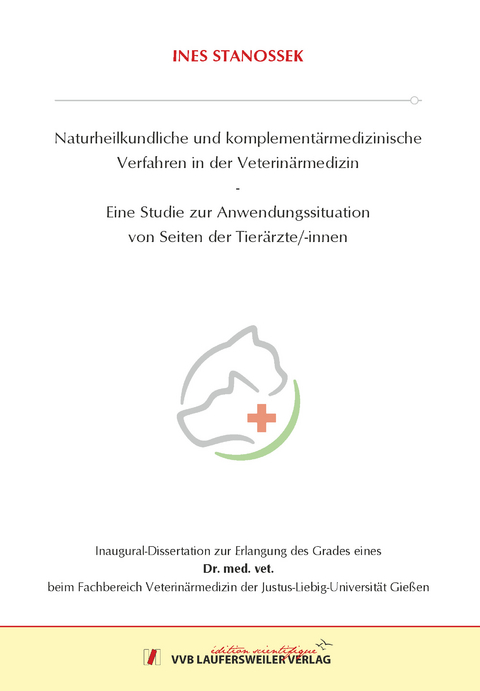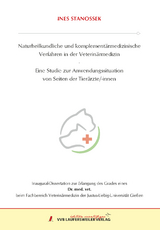Naturheilkundliche und komplementärmedizinische Verfahren in der Veterinärmedizin.
Eine Studie zur Anwendungssituation von Seiten der Tierärzte/ innen
Seiten
2021
VVB Laufersweiler Verlag
978-3-8359-6937-7 (ISBN)
VVB Laufersweiler Verlag
978-3-8359-6937-7 (ISBN)
- Keine Verlagsinformationen verfügbar
- Artikel merken
Naturheilkundliche und komplementärmedizinische Verfahren gewinnen in der Veterinärmedizin an Bedeutung. Eine Fülle verschiedener Verfahren stehen vielfältig informierten Besitzern gegenüber. Die vorliegende Querschnittsstudie widmet sich der momentanen Situation der praktisch tätigen Klein- und Heimtiermediziner in Bezug auf naturheilkundliche und komplementärmedizinische Verfahren. Sie erhebt welche Verfahren, bei welchen Indikationen angewendet werden. Zudem geht sie im Rahmen der wissenschaftlichen Diskussion um eine evidenzbasierte Medizin, Qualifikationen in diesem Bereich nach. Es soll aufgezeigt werden, ob sich das in der Literatur häufig erwähnte Interesse in der praktischen Tätigkeit wiederspiegelt. Gleichzeitig wurden Veterinärmediziner nach für sie bestehenden Vor- und Nachteilen der Anwendung naturheilkundlicher und komplementärmedizinischer Verfahren befragt.
Im ersten Studienteil wurde dazu ein zweiseitiger standardisierter Fragebogen mit Ergänzungsoptionen deutschlandweit verbreitet (als schriftliche oder online bereitgestellte Version). Es wurden 870 Fragebögen ausgewertet. Im zweiten Studienteil wurden 1083 Homepages von im Klein- und Heimtierbereich tätigen Tierärzten auf relevante Inhalte hin untersucht.
Einen Einfluss auf die Anwendung naturheilkundlicher und komplementärmedizinischer Verfahren zeigten hochsignifikant das Geschlecht und die Art der Tätigkeit als Selbstständiger oder Praxiseigner (p < 0,001). Signifikanten Einfluss hatte ebenso der Ort des Studienabschlusses (p = 0,027). Insgesamt wendeten 85,4 % aller Fragebogenteilnehmer (n = 679) naturheilkundliche und komplementärmedizinische Verfahren an (insbesondere Frauen), 60,7 % (n = 657) aller Homepages enthielten entsprechende Inhalte. Die im Fragebogen am häufigsten angewandten Verfahren waren die Komplexhomöopathie, die Phytotherapie, die klassische Homöopathie sowie biophysikalische Verfahren. In der Homepagerecherche fanden sich vor allem Angaben zu Homöopathie, TCM und biophysikalischen Verfahren. Als häufigste Einsatzbereiche wurden die Orthopädie, die Geriatrie und Stoffwechselerkrankungen genannt. Das Besitzerinteresse innerhalb der letzten fünf Jahre schätzten 57,9 % (n = 457) der Fragebogenteilnehmer als steigend ein. Die Frage der vorhandenen Qualifikationen im veterinärmedizinischen Bereich konnte auf Grund des Studiendesigns nur eingeschränkt beantwortet werden, 31,4 % (n = 206) aller Homepages machten hier entsprechende Angaben. Als Hauptinformationsquelle nutzten Tierärzte Fachzeitschriften und -bücher, gefolgt von durch die ATF anerkannten Fortbildungen. Die vorhandene Informationslage schätzten 39,5 % (n = 308) als eher ausreichend ein. Vorteile im Einsatz naturheilkundlicher und komplementärmedizinischer Verfahren wurden besonders in der Erweiterung des Behandlungsspektrums, der Kundenzufriedenheit und dem Einsatz von Verfahren mit geringeren Nebenwirkungen gesehen. Nachteile betrafen besonders die unklare Studienlage und die Erwartungshaltung der Besitzer. Die Homöopathie wurde hier als kritisches Verfahren an erster Stelle genannt.
Die Ergebnisse spiegeln die in der internationalen Literatur dargestellten Anwendungsgebiete und Verfahren und geben erstmals entsprechende Daten in der deutschen Klein- und Heimtiermedizin. Eine Datenbasis im naturheilkundlichen und komplementärmedizinischen Bereich eröffnet damit die Möglichkeit einer sachlichen Diskussion um entsprechende Verfahren in der Veterinärmedizin. Auf Grund der Reduktion der Komplexität dieses Themas zur Erfassung mittels Fragebogens, bleiben Anreize zukünftiger Fragestellungen wie der Erhebung genauerer Qualifikationsdaten. The use and interest in naturopathy and complementary veterinary medicine is increasing. Modes of treatment are diverse and face well informed owners. Small animal practitioners work in this area of conflict. The present study addresses the working situation of small animal practitioners in Germany in the field of naturopathy and complementary medicine. Methods of treatment and indications are explored and, in the demand of evidence based medicine, qualifications of veterinarians are described. In this context it is tried to confirm with numbers the often pronounced interest in naturopathy and complementary veterinary medicine. Benefits and disadvantages in the use of the methods are collected to map the current controversy in the field of CA(V)M.
A standardized two-sided questionnaire with open field additions was used. It was spread throughout Germany (in written and digital way). 870 questionnaires were evaluated. The second part of this study consisted of an examination of homepages (small animal practitioners) for naturopathy or complementary contents.
Gender and way of employment showed a strongly significant impact on the use of naturopathy and complementary medicine (p < 0.001), likewise did the place of final examinations (p = 0.027). Overall 85.4 % (n = 679) of all participants of the questionnaire used naturopathy and complementary medicine (most of them women). In addition 60.7 % (n = 657) of examined homepages presented relevant contents. The most commonly used treatments cited were complex homeopathy, phytotherapy, classic homeopathy and biophysical treatments. Homepages cited most frequently homeopathy, TCM and biophysical methods. The most common indication named were orthopedic, geriatric and metabolic diseases. Owner request for naturopathy and complementary treatments over the last five years was rated as growing with 57.9 % (n = 457). The design of the questionary did not allowed precise statements in terms of veterinary qualification in this field. But 31.4 % (n = 206) of all homepages contained statements for special qualifications. The most commonly used source of information for veterinarians were professional journals and publications followed by advanced training acknowledged by the ATF. Existing information was rated as adequate or nearly adequate by 39.5 % (n = 308) of all participants. The most commonly named advantages in using naturopathy and complementary medicine as a veterinarian were the expansion of treatment modalities, customer satisfaction and the use of treatments with lower side effects. Study situation, unknown way of action and the high expectations of owners were the most frequently named disadvantages. Especially homeopathy has been named here.
The results of this study confirm data from other authors referring to the applied modes of treatment and indications. They prove support in this area for Germany for the first time. Because of the reduction of information due to the used questionnaire there are a few points for further research. Modes of qualification and more personal attitudes towards naturopathy and complementary veterinary medicine could be some of them. Consolidated knowledge and profound data could and should be a potential for further objective discussion of naturopathy and complementary veterinary medicine and its treatment options.
Im ersten Studienteil wurde dazu ein zweiseitiger standardisierter Fragebogen mit Ergänzungsoptionen deutschlandweit verbreitet (als schriftliche oder online bereitgestellte Version). Es wurden 870 Fragebögen ausgewertet. Im zweiten Studienteil wurden 1083 Homepages von im Klein- und Heimtierbereich tätigen Tierärzten auf relevante Inhalte hin untersucht.
Einen Einfluss auf die Anwendung naturheilkundlicher und komplementärmedizinischer Verfahren zeigten hochsignifikant das Geschlecht und die Art der Tätigkeit als Selbstständiger oder Praxiseigner (p < 0,001). Signifikanten Einfluss hatte ebenso der Ort des Studienabschlusses (p = 0,027). Insgesamt wendeten 85,4 % aller Fragebogenteilnehmer (n = 679) naturheilkundliche und komplementärmedizinische Verfahren an (insbesondere Frauen), 60,7 % (n = 657) aller Homepages enthielten entsprechende Inhalte. Die im Fragebogen am häufigsten angewandten Verfahren waren die Komplexhomöopathie, die Phytotherapie, die klassische Homöopathie sowie biophysikalische Verfahren. In der Homepagerecherche fanden sich vor allem Angaben zu Homöopathie, TCM und biophysikalischen Verfahren. Als häufigste Einsatzbereiche wurden die Orthopädie, die Geriatrie und Stoffwechselerkrankungen genannt. Das Besitzerinteresse innerhalb der letzten fünf Jahre schätzten 57,9 % (n = 457) der Fragebogenteilnehmer als steigend ein. Die Frage der vorhandenen Qualifikationen im veterinärmedizinischen Bereich konnte auf Grund des Studiendesigns nur eingeschränkt beantwortet werden, 31,4 % (n = 206) aller Homepages machten hier entsprechende Angaben. Als Hauptinformationsquelle nutzten Tierärzte Fachzeitschriften und -bücher, gefolgt von durch die ATF anerkannten Fortbildungen. Die vorhandene Informationslage schätzten 39,5 % (n = 308) als eher ausreichend ein. Vorteile im Einsatz naturheilkundlicher und komplementärmedizinischer Verfahren wurden besonders in der Erweiterung des Behandlungsspektrums, der Kundenzufriedenheit und dem Einsatz von Verfahren mit geringeren Nebenwirkungen gesehen. Nachteile betrafen besonders die unklare Studienlage und die Erwartungshaltung der Besitzer. Die Homöopathie wurde hier als kritisches Verfahren an erster Stelle genannt.
Die Ergebnisse spiegeln die in der internationalen Literatur dargestellten Anwendungsgebiete und Verfahren und geben erstmals entsprechende Daten in der deutschen Klein- und Heimtiermedizin. Eine Datenbasis im naturheilkundlichen und komplementärmedizinischen Bereich eröffnet damit die Möglichkeit einer sachlichen Diskussion um entsprechende Verfahren in der Veterinärmedizin. Auf Grund der Reduktion der Komplexität dieses Themas zur Erfassung mittels Fragebogens, bleiben Anreize zukünftiger Fragestellungen wie der Erhebung genauerer Qualifikationsdaten. The use and interest in naturopathy and complementary veterinary medicine is increasing. Modes of treatment are diverse and face well informed owners. Small animal practitioners work in this area of conflict. The present study addresses the working situation of small animal practitioners in Germany in the field of naturopathy and complementary medicine. Methods of treatment and indications are explored and, in the demand of evidence based medicine, qualifications of veterinarians are described. In this context it is tried to confirm with numbers the often pronounced interest in naturopathy and complementary veterinary medicine. Benefits and disadvantages in the use of the methods are collected to map the current controversy in the field of CA(V)M.
A standardized two-sided questionnaire with open field additions was used. It was spread throughout Germany (in written and digital way). 870 questionnaires were evaluated. The second part of this study consisted of an examination of homepages (small animal practitioners) for naturopathy or complementary contents.
Gender and way of employment showed a strongly significant impact on the use of naturopathy and complementary medicine (p < 0.001), likewise did the place of final examinations (p = 0.027). Overall 85.4 % (n = 679) of all participants of the questionnaire used naturopathy and complementary medicine (most of them women). In addition 60.7 % (n = 657) of examined homepages presented relevant contents. The most commonly used treatments cited were complex homeopathy, phytotherapy, classic homeopathy and biophysical treatments. Homepages cited most frequently homeopathy, TCM and biophysical methods. The most common indication named were orthopedic, geriatric and metabolic diseases. Owner request for naturopathy and complementary treatments over the last five years was rated as growing with 57.9 % (n = 457). The design of the questionary did not allowed precise statements in terms of veterinary qualification in this field. But 31.4 % (n = 206) of all homepages contained statements for special qualifications. The most commonly used source of information for veterinarians were professional journals and publications followed by advanced training acknowledged by the ATF. Existing information was rated as adequate or nearly adequate by 39.5 % (n = 308) of all participants. The most commonly named advantages in using naturopathy and complementary medicine as a veterinarian were the expansion of treatment modalities, customer satisfaction and the use of treatments with lower side effects. Study situation, unknown way of action and the high expectations of owners were the most frequently named disadvantages. Especially homeopathy has been named here.
The results of this study confirm data from other authors referring to the applied modes of treatment and indications. They prove support in this area for Germany for the first time. Because of the reduction of information due to the used questionnaire there are a few points for further research. Modes of qualification and more personal attitudes towards naturopathy and complementary veterinary medicine could be some of them. Consolidated knowledge and profound data could and should be a potential for further objective discussion of naturopathy and complementary veterinary medicine and its treatment options.
| Erscheinungsdatum | 09.03.2021 |
|---|---|
| Reihe/Serie | Edition Scientifique |
| Verlagsort | Gießen |
| Sprache | deutsch |
| Maße | 148 x 210 mm |
| Gewicht | 230 g |
| Themenwelt | Naturwissenschaften |
| Veterinärmedizin ► Allgemein | |
| Schlagworte | Doktorarbeit • Naturmedizin • Promotion |
| ISBN-10 | 3-8359-6937-4 / 3835969374 |
| ISBN-13 | 978-3-8359-6937-7 / 9783835969377 |
| Zustand | Neuware |
| Informationen gemäß Produktsicherheitsverordnung (GPSR) | |
| Haben Sie eine Frage zum Produkt? |

